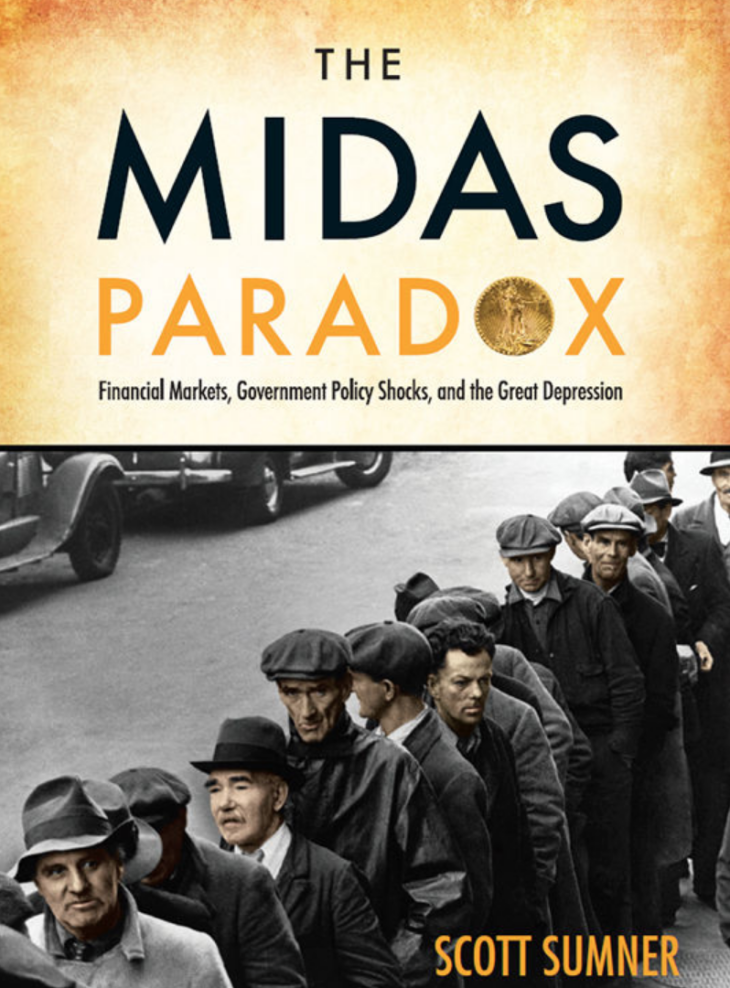Market monetarists like myself have criticized the “wait and see” approach used by many macroeconomists. This refers to the tendency of economists to watch how the economy plays out over time, after a new policy initiative. This technique is not reliable, as the economy is constantly being buffeted by all sorts of shocks, and it’s not easy to isolate the impact of any one shock. Instead, the immediate impact of policy announcements on market forecasts provides the best indication of whether stabilization policy is on target or off course.
In 1933, FDR gradually depreciated the dollar in order to boost prices and output. As the year progressed, opposition to the program increased. Even Keynes (who initially supported the policy) called for a halt in the dollar depreciation policy toward the end of 1933. FDR’s critics made the mistake of assuming that we needed to “wait and see” how the policy would impact the economy.
In fact, FDR should have depreciated the dollar even further. One economist who did understand this was George Warren, the FDR advisor who had advocated the policy. In my book on the Great Depression, I drew some parallels between this episode and modern policy errors:
The distinction between flexible (commodity) prices and a sticky overall price level is crucial to any understanding of Roosevelt’s policy. For instance, when Roosevelt decided to formally devalue the dollar in January 1934, many prominent economists such as E.W. Kemmerer predicted runaway inflation. Prices did rise modestly but remained well below pre-Depression levels throughout the 1930s. Pearson, Myers, and Gans quote Warren’s notes to the effect that when the summer of 1934 arrived without substantial increases in commodity prices:
The President (a) wanted more inflation and (b) assumed or had been led to believe that there was a long lag in the effect of depreciation. He did not understand—as many others did not then and do not now—the principle that commodity prices respond immediately to changes in the price of gold. (1957, p. 5664)
Warren understood that commodity markets in late January 1934 had already priced in the anticipated impact of the devaluation, and that commodity price indices were signaling that a gold price of $35/ounce was not nearly sufficient to produce the desired reflation. Most modern macroeconomists continue to make this mistake, taking a “wait and see” attitude toward initiatives such as “quantitative easing,” whereas the inflation expectations embedded in the Treasury Inflation-Protected Securities (TIPS) markets provided immediate evidence that the policy was nowhere near sufficient.
During 2009-10, many conservatives wrongly predicted that QE would be highly inflationary, and in 2012 many Keynesians wrongly predicted that the 2013 fiscal austerity would be highly contractionary. Both groups could have avoided their errors by looking at market forecasts.
The majority of economic historians seem to view George Warren as a bit of a crackpot. In fact, he was well ahead of the profession, and still is.
In macroeconomics, there’s (almost) nothing new under the sun, including market monetarism.


READER COMMENTS
Benjamin Cole
May 21 2019 at 7:32pm
Interesting post. Macroeconomic policy makers have ever been tormented by phantoms.
There never was a Great Depression in Japan. Japan’s Finance Minister Takahashi Korekiyo took the nation off the gold standard and went to money-finance fiscal programs early in the 1930s to positive effect.
Thaomas
May 21 2019 at 7:38pm
Thaomas
May 21 2019 at 7:39pm
Of course the errors are somewhat different. Keynesians were correct as a ceteris paribus prediction. They over looked the monetary policy offset. The QE as inflationary is wrong ceteris paribus.
Lorenzo from Oz
May 21 2019 at 8:27pm
So “wait and see” represents a failure to understand how expectations work in commerce.
Brian Donohue
May 22 2019 at 11:25am
Excellent post. Maybe monetary policy is like logrolling, as if we need another metaphor.
Ilya Novak
May 22 2019 at 7:28pm
How do we know that the lessons of the the Great Depression apply to our economy today if back then we were on the gold standard and now we’re on the pure fiat economy? Maybe the lessons just don’t apply anymore for our world.
Scott Sumner
May 22 2019 at 8:58pm
Ilya, Some lessons do not apply today. But I see no reason why markets would stop being a useful indicator of the expected impact of monetary policy, just because we switched to fiat money.
Greg Jaxon
May 26 2019 at 8:23pm
Ilya is right to warn that FDR’s monetary regime change confounds most easy analogies between then and now. Having devalued all the outstanding dollar-denominated debts and shut down the domestic gold market caused tremendous planning chaos for international businesses. Scott is right to trust only market participants’ deeds, not their words. If he would learn from this lesson that such trust is warranted always and everywhere, perhaps we could dispose of this misguided merchantilist regime of monetary policymaking and return to organic market-based monies.
Comments are closed.